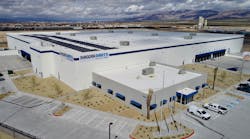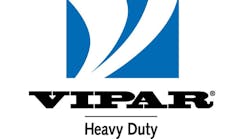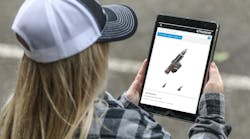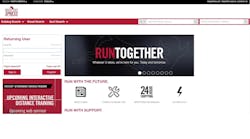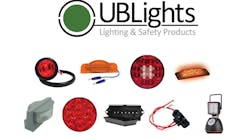WHILE the commercial truck body and trailer business was hit hard during the past few years and now appears to be bouncing back strong, industry parts departments have been far more consistent, according to the results of last month's Trailer/Body Builders survey.
A few weeks ago, Trailer/Body Builders asked industry executives a wide range of questions about their parts departments — what effects the recession had on their business and what they did in response. We also asked about parts sales, inventory values, salary levels, and other key factors affecting parts operations. We sent e-mails requesting parts executives to provide their feedback, and we posted an invitation on our website (www.trailer-bodybuilders.com) for others to do the same.
Truck equipment distributors, trailer dealers, parts specialists, repair shops, truck dealers, and even parts manufacturers submitted 245 completed surveys. Because the goal was to survey retail parts departments, we treated the parts manufacturers responses separately (see a summary of their responses at the end of this report), leaving 230 responses from companies that meet the criteria.
The responses were fairly consistent across the board. Truck equipment distributors, trailer dealers, parts specialists, repair shops, and truck dealers all reported that parts sales in 2010 will be within 2% of last year's sales — either positively or negatively. The one exception involved truck dealers. They on average reported parts were selling at a pace that would fall 11% short of last year's sales. Here are the averages for each major group that participated in the survey:
-
Truck equipment distributors sold $594,697 in parts last year. They are on a pace to sell $583,333 in 2010, down 2%.
-
Trailer dealers posted an average of $872,449 in parts sales in 2009, and they expect sales to slip to $852,040 this year — a 2% decline.
-
Parts specialists sold an average of $3,125,000 in parts sales last year. They expect that figure to remain unchanged in 2010.
-
Repair shops also expect virtually no change in their parts volume this year. They sold an average of $220,000 last year and believe sales will nudge up less than 1% in 2010.
-
Truck dealers had parts sales of $2,500,000 in 2009, but they expect sales to decline 11% this year.
Overall, the industry is making a little less profit on those sales in 2010 based on data showing a slight decline in gross margins. The average parts department in the industry generated a 24.24% gross margin in 2009, but margins appear to have eroded slightly this year, averaging 23.26% industry wide.
Responding to recession
Industry parts departments did not feel the impact e the economic downturn nearly as dramatically as the companies as a whole. While overall sales were off sharply, parts departments were off only slightly — and sometimes reported sales increases.
When asked to describe the effect that the recession had on their company as a whole, 87% said the impact was negative, including 25% who described the impact as “extremely negative.” By contrast, the recession had a negative impact on 67% of industry parts departments, and only 8% of respondents described the effect as “extremely negative. While only 5% of respondents said the recession had a positive impact on their company, the downturn benefitted almost 15% of the parts departments.
The difference between the impact on the parts department and overall company was most pronounced among truck dealers and least pronounced, not surprisingly, among parts specialists.
How did industry parts departments respond to the downturn? Fifty-seven percent of the companies engaged in more aggressive selling, 38% cut their gross margins, 35% cut staff and instituted a hiring freeze, and 17% cut salary.
The breakdown by type:
-
Truck-equipment distributors (69): 51% engaged in more aggressive selling, 44% cut their gross margins, 37% cut staff and instituted a hiring freeze, and 18% cut salary.
-
Trailer dealers (49): 71% engaged in more aggressive selling, 35% cut their gross margins, 37% cut staff, 33% instituted a hiring freeze, and 12% cut salary.
-
Parts specialists (30): 66% engaged in more aggressive selling, 34% cut their gross margins, 45% cut staff, 34% instituted a hiring freeze, and 28% cut salary.
-
Repair shops (42): 40% engaged in more aggressive selling, 38% cut their gross margins, 29% cut staff, 33% instituted a hiring freeze, and 7% cut salary.
-
Truck dealers (12): 91% engaged in more aggressive selling, 18% cut their gross margins, 27% cut staff, 27% instituted a hiring freeze, and 27% cut salary.
Parts department employment:
Slightly fewer faces, but greater sales per employee
Parts departments resisted the idea of reducing their number of employees, but enough parts departments have scaled back headcounts to make a difference in overall averages.
The average industry parts department currently has 3.09 employees, down 5% from a year ago. The numbers varied, however, among the different types of companies that participated in the survey. Specifically:
-
Truck equipment distributors have reduced parts department employees by just over 9%, according to the results of the survey. They had an average of 2.65 employees in 2009. That number has dropped to 2.4 this year.
-
Trailer dealers employed 4.14 people on average in 2009. The average has slipped to 4.02 this year — a 3% decline.
-
Parts specialty companies held employment fairly steady — an average of 4.4 employees per parts department currently, down 1.5% from the 4.47 average last year.
-
Repair shops employed an average of 1.24 people last year. That number has fallen to 1.05 in 2010. While the decline does not seem large, it represents a 15.4% bump in job losses.
-
Truck dealers also reported a slight decline in parts department employment — 3.8%. The average truck dealer employs 5.72 people today, down from 5.91 a year ago.
More sales per employee
The employees of industry parts departments appear to be selling a little more than they did in 2009, according to the results of the survey. Dividing the average sales by the average number of employees produced the following results:
-
Overall, industry parts departments sold an average of $237,570 dollars for every parts department employee in 2009. That average edged up to $247,642 in 2010 — a 4% increase.
-
Truck equipment distributors, a group that reduced the number of parts department employees by 9% in 2010, saw sales per employee grow by 8%. Parts sales per employee averaged $224,230 last year but are up to $241,870 so far in 2010.
-
Trailer dealers also posted gains in parts sales per employee. The average this year is $211,929, up from $210,591 in 2009.
-
Parts specialists, a group that reduced headcount by 1.49% this year, experienced a 1.52% gain in sales per parts employee. The average parts specialist generated $699,627 sales per employee last year. That average stands at $710,227 currently.
-
Repair shops had particularly sharp changes. This group cut its parts department employees by 15% and experienced an 18% gain in sales per employee. However, the average sales per employee in 2009 had been the lowest in the industry — $177,692. The average has improved to $210,698 this year.
-
Truck dealers were the only group to experience an erosion in sales per employee. They averaged $423,077 in 2009, but are down to $388,889 (-8%) in 2010.
Parts department salaries:
Working a little harder, earning a little bit less
Employees of industry parts departments appear to be generating slightly more sales these days, and they are earning a little less, according to the results of the survey.
Based on the survey results, employees of all three key positions — parts manager, inside sales, and outside sales — all are earning the same or slightly less than they did in 2009.
Overall, a parts manager in the commercial truck and trailer industry earned $43,641 in 2009. This year, the average has slipped 2% to $42,680. Here is a look at the salary trends for each major type of parts department in the commercial truck and trailer industry:
-
Truck equipment distributors reported an average salary of $43,000 for their parts managers in 2009. They are on pace to earn $41,500 this year, down 3.5% from a year ago. Inside parts sales personnel earned $39,482 last year and stand to be paid $37,457 this year, a 5% decrease. Outside parts personnel received $45,555 in 2009 and will earn an estimated $44,259 this year — down 3%.
-
Trailer dealers paid their parts managers an average of $46,363 in 2009, the same as they did in 2010. Inside parts sales personnel, received just over a 1% raise on average this year. They are earning $32,272 in this year, compared with $31,818 in 2009. Outside sales personnel, however are earning about 2.5% less than they did in 2009. The numbers: $41,282 last year, $40,256 in 2010.
-
Parts specialty companies lowered compensation for all three of these positions. Parts manager salaries declined 2%, from $46,956 last year to $45,909 currently. Inside parts sales personnel earned $35,454 last year, 1% more than the $35,000 that they are expected to earn this year. Outside sales personnel are earning $47,272 in 2010, down 2% from the $48,181 that they received in 2009.
-
Repair shops are paying their parts managers $30,263 this year, down 5% from the $31,842 parts managers earned last year. Inside and outside parts sales personnel, however, are earning about a half percent more this year. Compensation for inside parts sales averaged $29,459 last year, compared with the current rate of $29,583. Outside sales personnel are receiving $28,181 currently, up from $28,030 last year.
-
Truck dealers have reduced the compensation for parts managers, but the sales guys are beating the inflation rate this year. The truck dealers participating in the survey will earn $63,000 on average this year, down 3% from the $65,000 that they received in 2009. The average earnings for inside sales has increased 4%, from $45,454 in 2009 to $47,272 this year. Outside sales personnel are fairing even better. They brought home $55,556 last year, but they will earn an estimated $58,889 in 2010 — a 6% increase.
Buying trends
What hot new products are parts departments adding? Where are they sourcing their purchases? According to the results of the survey:
The top source for components for 31 of the 64 participating distributors is directly from parts manufacturers. Another 27 buy primarily from a parts program from the manufacturers they represent, and six from an aftermarket buying group.
Exactly half of the 48 trailer dealers said they buy from a parts program from the manufacturer they represent, 13 from an aftermarket buying group, and 11 direct from parts manufacturers.
Thirteen of 27 parts specialists said they buy direct from parts manufacturers, 11 from a parts program from the manufacturer they represent, and three from an aftermarket buying group.
Twenty-two of 41 repair shops said they buy from an aftermarket buying group, 14 from a parts program from the manufacturer they represent, and five direct from parts manufacturers.
Ten of 11 truck dealers said they buy from a parts program from the manufacturer they represent and one from an aftermarket buying group.
Improving supplier performance
We asked the survey participants to list one thing that their aftermarket replacement parts supplier could do to offer better service. For all the groups, the most common responses were better pricing, quicker delivery, and shorter lead times.
For trailer dealers, other responses were: better communication, diversify, provide invoices faster, increase and improve product training, lower minimum for free freight, inform them on where the parts are manufactured, offer more product lines, and stop making the parts available from so many sources and outlets.
For truck-equipment distributors: better quality, closer and more accurate communication, easier online parts research and purchasing processes, more inventory, and more people taking parts calls.
For parts specialists: develop better freight deals with UPS and FedEx overnight; reduce back orders; offer better terms for payment; respect the distribution chain and stop selling direct to our customers.
For repair shops: better quality, closer and more accurate communication, easier online parts research and purchasing processes, more inventory, and more people taking parts calls.
For truck dealers: better cross referencing.
Best new product
We asked the survey participants to list the best new product they've added in the past three years. For truck-equipment distributors, it was Buyers snowplows; for trailer dealers, LED lights; for parts specialists, DEF lines; for repair shops, liftgates and liftgate parts; for truck dealers, a tie between aftermarket radiators, brake-shoe program, electronics, Mack parts, offshore parts availability, Panasonic refrigerators; and PTO and bed bumps.
For our final question, we asked them to name the biggest trend affecting their parts department today. The two most common answers were price wars through increased competition from companies willing to lower their gross margins and offshore sales, and a lack of sales (whether from tight budgets from companies and municipalities or an economy that isn't rapidly growing).
For trailer dealers, other responses were: fleets running long and hard, with as little maintenance as possible; getting customers to think of a trailer dealer when looking for truck parts; idle equipment; industry consolidation and the availability of working capital; and the increasing amount of technology on trucks and trailers.
For parts specialists: EPA compliance, fewer fleets, fewer small customers, late payments, and OEM trailer manufacturers “dumping inventory” in the parts market.
For repair shops: cash flow, consignments, customers not doing preventive maintenance, changes caused by new models, more aftermarket and counterfeit parts being sold in the market, owner-operators buying parts and wanting us to install them, and California emissions requirements.
For truck dealers: acquisition of major fleet accounts, and customers “paying by terms/receivables.”


